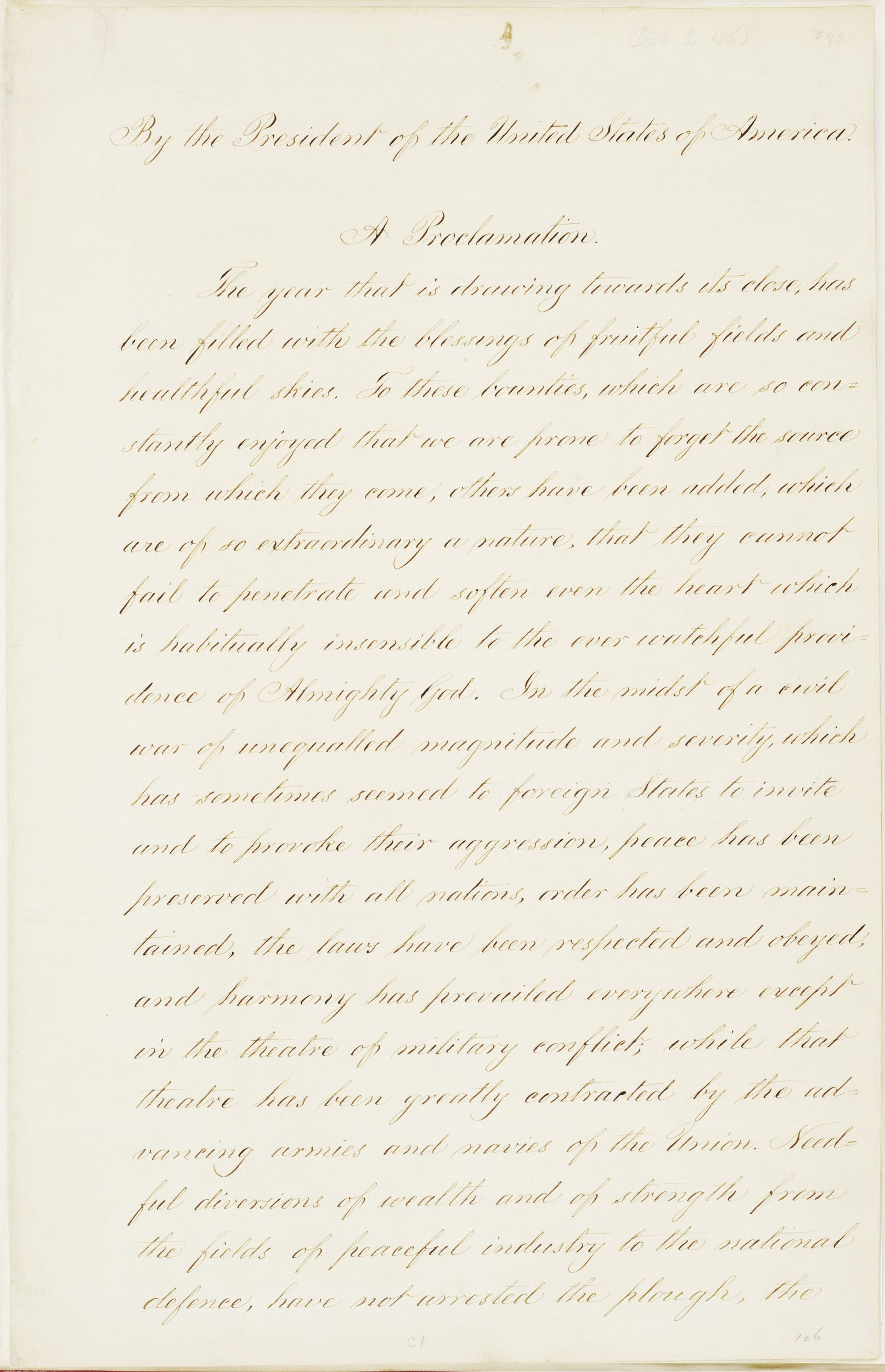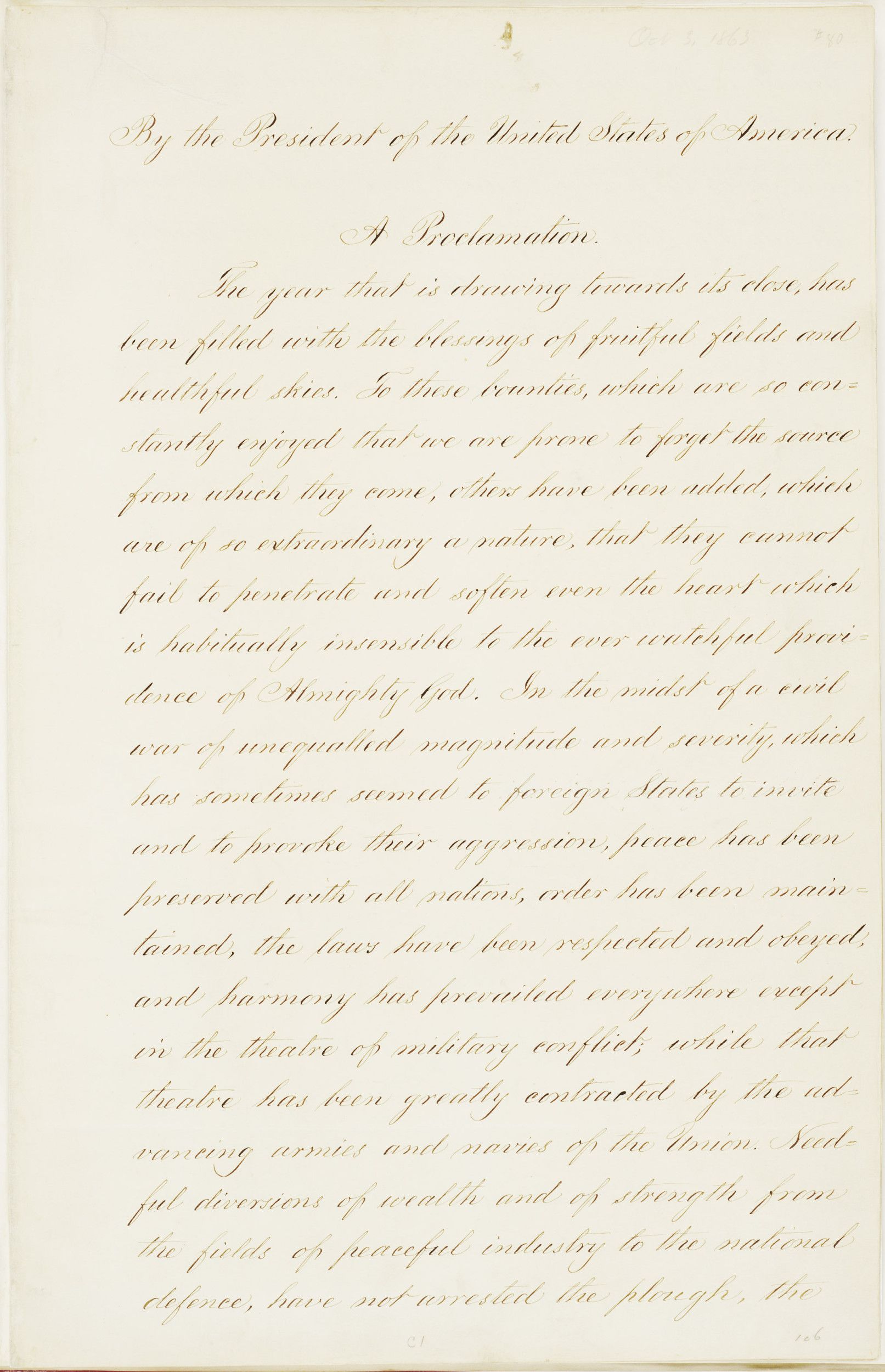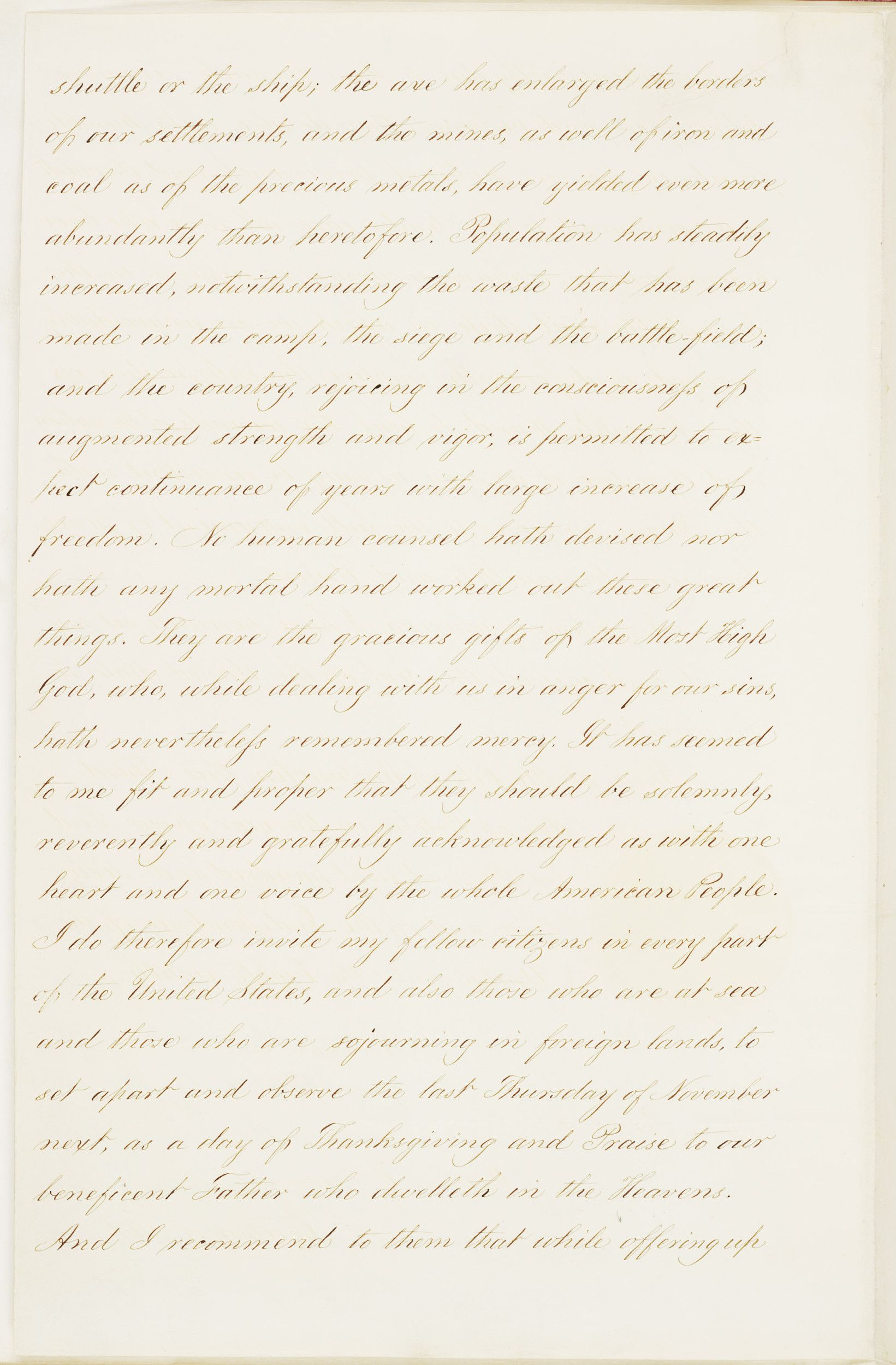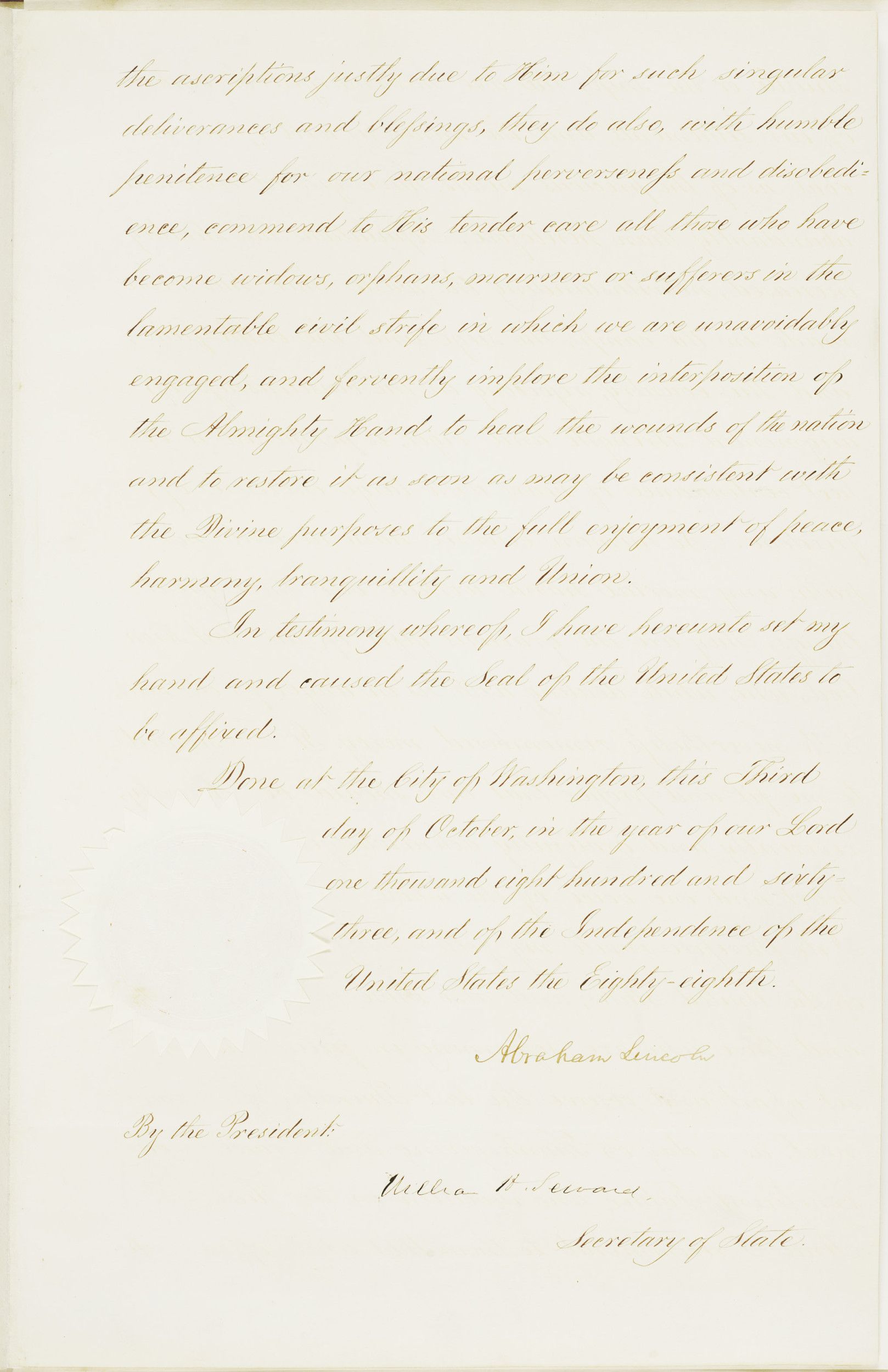President Lincoln's 1863 Thanksgiving Proclamation
Making Connections
All documents and text associated with this activity are printed below, followed by a worksheet for student responses.Introduction
What do you think of when you hear the word Thanksgiving? Perhaps it's the gathering of friends and family, turkey, cranberry relish, mashed potatoes, pumpkin pie, and watching football. But how did this national holiday come about?Historical Background:
The autumn harvest feast shared by the Plymouth colonists and the Wampanoag Indians in 1621 is often acknowledged as one of the first Thanksgiving celebrations in the colonies. In 1846, Sarah Josepha Hale, a writer and editor of Godey Lady's Book, began a campaign for a national day of Thanksgiving. Hale wrote letters to presidents and politicians, and to newspapers advocating for a day of Thanksgiving celebrated by all states. In September 1863, Hale wrote to both President Abraham Lincoln and Secretary of State William Seward. On October 3, 1863, President Lincoln issued a Thanksgiving Proclamation designating a national day of Thanksgiving.
Instructions:
Examine President Lincoln's 1863 Thanksgiving Proclamation. Click on View Document Details to see all three pages. Then focus on a the particular passage from the proclamation that is provided, and answer the questions that follow. Next, study the engraving "The Union Altar." Share three examples of how the engraving reflects the text of the Thanksgiving Proclamation.
Name:
Class:
Class:
Worksheet
President Lincoln's 1863 Thanksgiving Proclamation
Making Connections
Examine the documents and text included in this activity. Fill in any blanks in the sequence with your thoughts and write your conclusion response in the space provided.President Abraham Lincoln`s Thanksgiving Day Proclamation of October 3, 1863 (Presidential Proclamation 106).

Read the selected passage from President Lincoln's 1863 Thanksgiving Proclamation that follows in the next box. As you do so, identify and look up unfamiliar words. In the blank box that follows, answer: 1) What is the civil strife? 2) Who are the widows, orphans, mourners or sufferers? 3) What is the purpose of the line "heal the wounds of the nation and to restore it...to the full enjoyment of peace, harmony, tranquillity and Union."
"I do therefore invite my fellow citizens in every part of the United States, and also those who are at sea and those who are sojourning in foreign lands, to set apart and observe the last Thursday of November next, as a day of Thanksgiving and Praise to our beneficent Father who dwelleth in the Heavens. And I recommend to them that while offering up the ascriptions justly due to Him for such singular deliverances and blessings, they do also, with humble penitence for our national perverseness and disobedience, commend to His tender care all those who have become widows, orphans, mourners or sufferers in the lamentable civil strife in which we are unavoidably engaged, and fervently implore the interposition of the Almighty Hand to heal the wounds of the nation and to restore it as soon as may be consistent with the Divine purposes to the full enjoyment of peace, harmony, tranquillity and Union."
Enter your response
Closely examine the next image, the engraving, "The Union Altar" by Thomas Nast, that was published in "Harper's Weekly" on December 5, 1863. In the blank box that follows, list three examples of how the engraving reflects Lincoln's Proclamation.
Nast, Thomas. "The Union Altar." Harper's Weekly. Dec. 5, 1863. Accessed online at: https://www.gilderlehrman.org/history-resources/spotlight-primary-source/thanksgiving-proclamation-1863

Enter your response
1
Activity Element
President Abraham Lincoln`s Thanksgiving Day Proclamation of October 3, 1863 (Presidential Proclamation 106).
Page 1

2
Activity Element
Nast, Thomas. "The Union Altar." Harper's Weekly. Dec. 5, 1863. Accessed online at: https://www.gilderlehrman.org/history-resources/spotlight-primary-source/thanksgiving-proclamation-1863

Conclusion
President Lincoln's 1863 Thanksgiving Proclamation
Making Connections
Presidents since Abraham Lincoln have issued a Thanksgiving Proclamation every year, appointing the day set by Lincoln – the "last Thursday in November" – as the official day of national Thanksgiving. In 1939, President Franklin D. Roosevelt moved the holiday to the third Thursday of November to lengthen the Christmas shopping season. After protests from across the nation, in 1941 Congress passed a joint resolution (H.J. Res. 41) declaring the Federal Thanksgiving Day holiday the "fourth Thursday in November."Explain three reasons why a national day of Thanksgiving has been important to the United States.
Your Response
Document
President Abraham Lincoln's Thanksgiving Day Proclamation of October 3, 1863 (Presidential Proclamation 106)
10/3/1863
On September 28, 1789, just before leaving for recess, the first Federal Congress passed a resolution asking that the President of the United States recommend to the nation a day of thanksgiving. A few days later, President George Washington issued a proclamation naming Thursday, November 26, 1789 as a "Day of Publick Thanksgivin" - the first time Thanksgiving was celebrated under the new Constitution. Subsequent presidents issued Thanksgiving Proclamations, but the dates and even months of the celebrations varied. It wasn't until President Abraham Lincoln's 1863 Proclamation (Presidential Proclamation 106) that Thanksgiving was regularly commemorated each year on the last Thursday of November.
In the years since, though not a requirement, Presidential proclamations of Thanksgiving have served as an enduring tradition offering a unique look into the various struggles that were affecting Americans around this time of year. It is customary for each President to release a statement every year to officially acknowledge the nationwide celebration of the holiday.
In the years since, though not a requirement, Presidential proclamations of Thanksgiving have served as an enduring tradition offering a unique look into the various struggles that were affecting Americans around this time of year. It is customary for each President to release a statement every year to officially acknowledge the nationwide celebration of the holiday.
Transcript
[page 1]By the President of the United States of America
A Proclamation.
The year that is drawing towards its close, has been filled with the blessings of fruitful fields and healthful skies. To these bounties, which are so constantly enjoyed that we are prone to forget the source from which they come, others have been added, which are of so extraordinary a nature, that they cannot fail to penetrate and soften even the heart which is habitually insensible to the ever watchful providence of Almighty God. In the midst of a civil war of unequalled magnitude and severity, which has sometimes seemed to foreign States to invite and to provide aggressions, peace has been preserved with all nations, order has been maintained, the laws have been respected and obeyed, and harmony has prevailed everywhere except in the theatre of military conflict; while that theatre has been greatly contracted by the advancing armies and navies of the Union. Needful diversions of wealth and of strength from the fields of peaceful industry to the national defence, have not arrested the plough, the
[page2]
shuttle or the ship; the axe has enlarged the borders of our settlements, and the mines, as well of iron and coal as of the precious metals, have yielded even more abundantly than heretofore. Population has steadily increased, notwithstanding the waste that has been made in the camp, the siege and the battle-field; and the country, rejoicing in the consciousness of augmented strength and vigor, is permitted to expect continuance of years with large increase of freedom. No human counsel hath devised nor hath any mortal hand worked out these great things. They are the gracious gifts of the Most High God, who, while dealing with us in anger for our sins, hath nevertheless remembered mercy. It has seemed to me fit and proper that they should be solemnly, reverently and gratefully acknowledged as with one heart and one voice by the whole American People. I do therefore invite my fellow citizens in every part of the United States, and also those who are at sea and those who are sojourning in foreign lands, to set apart and observe the last Thursday of November next, as a day of Thanksgiving and Praise to our beneficent Father who dwelleth in the Heavens. And I recommend to them that while offering up
[page3]
the ascriptions justly due to Him for such singular deliverances and blessings, they do also, with humble penitence for our national perverseness and disobedience, commend to His tender care all those who have become widows, orphans, mourners or sufferers in the lamentable civil strife in which we are unavoidably engaged, and fervently implore the interposition of the Almighty Hand to heal the wounds of the nation and to restore it as soon as may be consistent with the Divine purposes to the full enjoyment of peace, harmony, tranquillity and Union.
In testimony whereof, I have hereunto set my hand and caused the Seal of the United States to be affixed.
Done at the City of Washington, this Third day of October, in the
year of our Lord one thousand eight hundred and sixty-three, and of
the Independence of the United States the Eighty-eighth.
[signed] Abraham Lincoln
By the President
[signed] William H. Seward
Secretary of State
This primary source comes from the General Records of the United States Government.
National Archives Identifier: 299960
Full Citation: President Abraham Lincoln's Thanksgiving Day Proclamation of October 3, 1863 (Presidential Proclamation 106); 10/3/1863; Presidential Proclamations, 1791 - 2016; General Records of the United States Government, ; National Archives Building, Washington, DC. [Online Version, https://docsteach.org/documents/document/lincoln-thanksgiving-proclamation, April 19, 2024]President Abraham Lincoln's Thanksgiving Day Proclamation of October 3, 1863 (Presidential Proclamation 106)
Page 1

President Abraham Lincoln's Thanksgiving Day Proclamation of October 3, 1863 (Presidential Proclamation 106)
Page 2

President Abraham Lincoln's Thanksgiving Day Proclamation of October 3, 1863 (Presidential Proclamation 106)
Page 3

